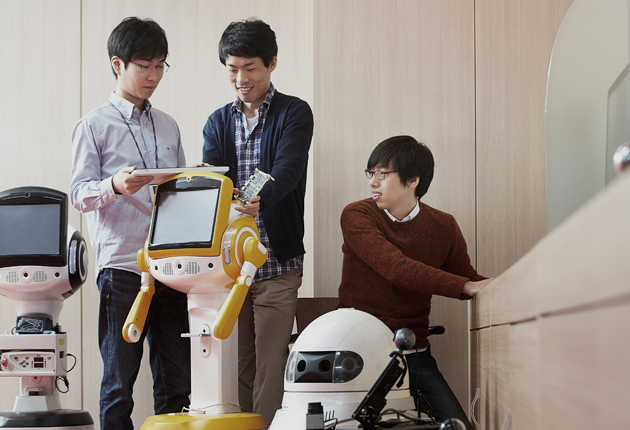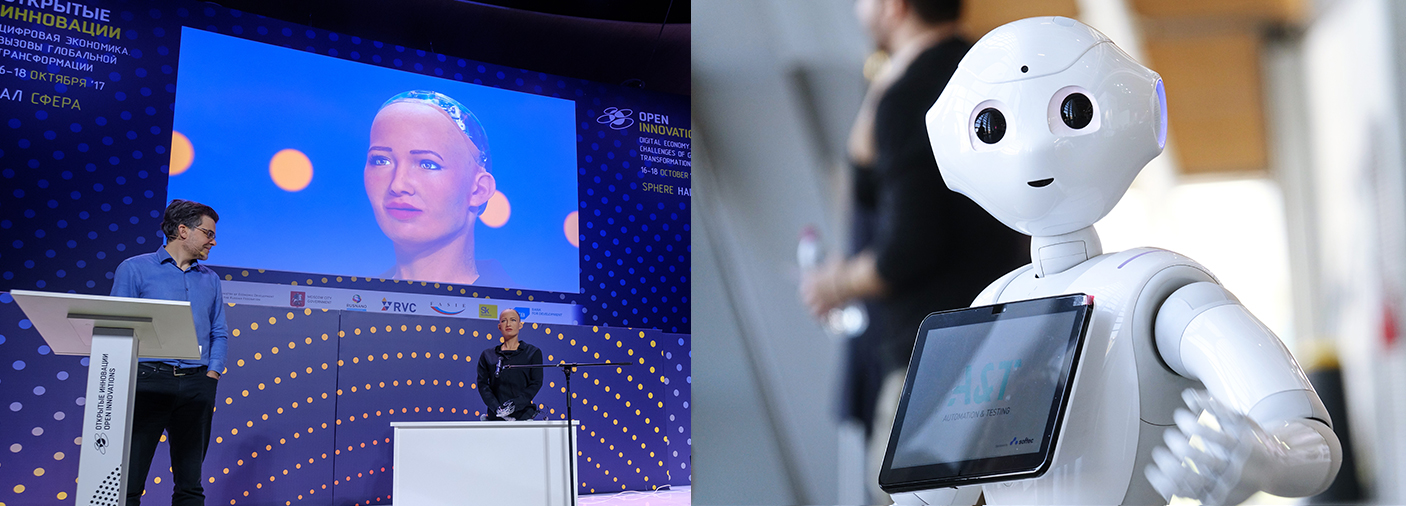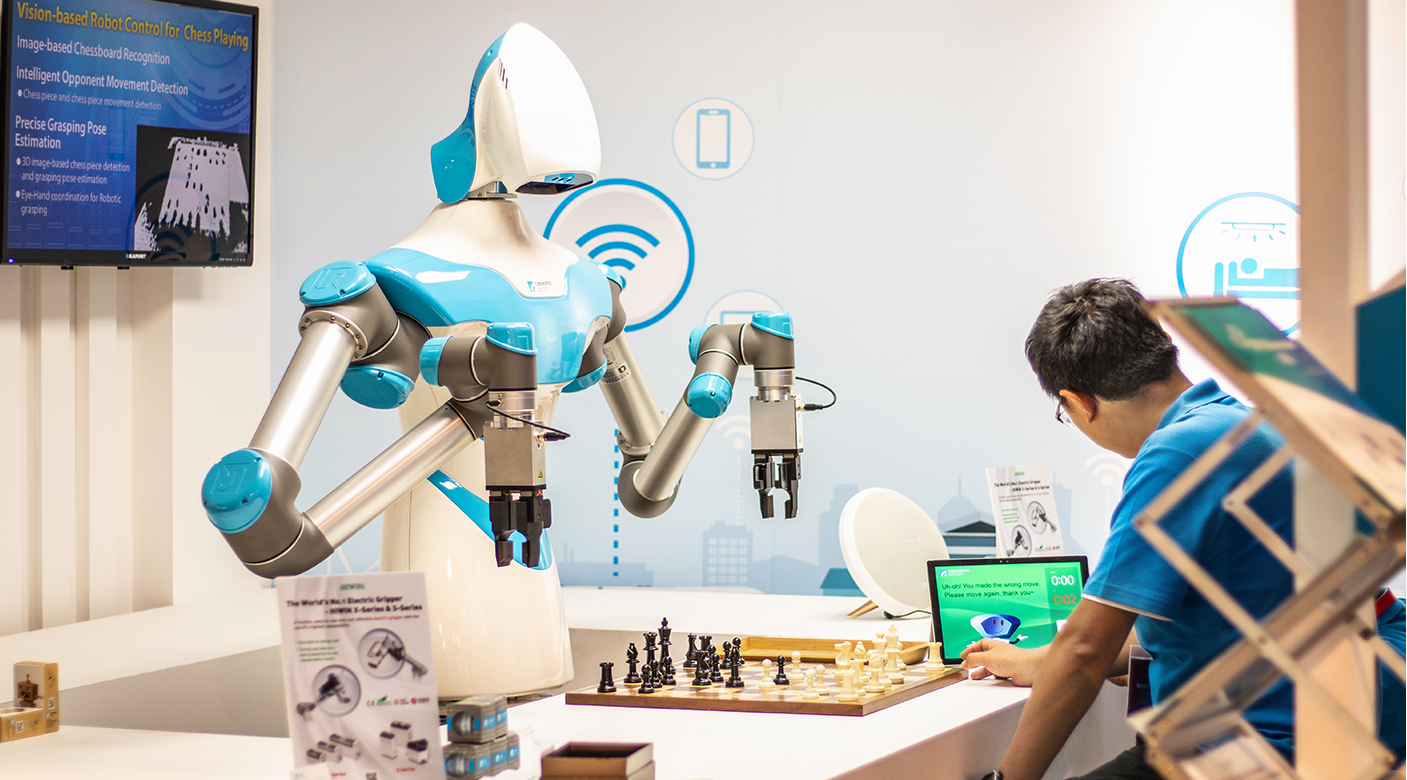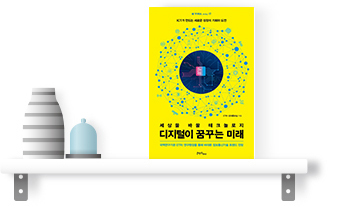VOL.51
April 2019


ICT Trend ____ Intelligent Cognitive Robot Technology
Will Robots Take
away Our Jobs?
Intelligent Cognitive Robot Technology
McKinsey, a global consulting firm, issued a report forecasting that nearly 800 million jobs of today could be lost worldwide by 2030 to robot labor and automation. The figure corresponds to 20% of the global workforce. This warns us that, although this rate of replacement may be slower than anticipated, e.g., half the predicted pace, nearly 400 million people will be forced out of jobs over the next ten years, and we must strive to create new jobs to compensate these losses.


An intelligent cognitive robot under development by ETRI in an attempt to improve the quality of human life and ensure a sufficient workforce
Cognitive Robots Moving into Our Daily Lives
Klaus Schwab, the executive chairman of the World Economic Forum who made the Fourth Industrial Revolution the main topic of discussion worldwide, predicted that the Fourth Industrial Revolution would give rise to nearly 2.1 million new jobs by 2020, but at the same time, nearly 7.1 million jobs would be gone. He also added that for the next three years, about 5 million jobs would be lost to robots or AI solutions.
Likewise, robots are deeply moving into our daily lives. The International Robot Exhibition 2017 (iREX 2017), which was held at Tokyo Big Site for four days from November 29, 2017, provided a glimpse of how this possibility will turn into reality. The theme of the exhibition was “The Robot Revolution Has Begun: Toward Heartwarming Society.” One of the robots presented at the exhibition demonstrated its ability to move each of its finger joints and fold towels and keep them stacked. Another robot prepared a lunch box by precisely picking up chicken and fruit. Firefighting robots cooperated to complete their mission: first, flying firefighting robots precisely identify and locate the fire spot, and subsequently remotely controlled ground robots extinguish the fire where humans cannot access. IBM’s Watson already impressed the world with its 2011 win against the greatest champions of Jeopardy, a popular US quiz show. Recently, the software was used in an attempt to create cooking recipes. As it stands now, we will soon see robot clerics or funerals hosted by robots. The 2013 film Her, which featured a human and an AI sharing each other’s feelings, was a huge hit. Part of its popularity came from Scarlett Johansson, an actress who charmingly voiced Samantha, the AI OS. Recently, there has been news that Google DeepMind is developing technology that enables AI solutions to have a human voice like that of Samantha using deep learning. Soon, we may see a smartphone AI assistant that speaks as Samantha does.
What makes such an application is deep learning, one of the AI-based technologies. This is a machine learning technology that enables machines to think, summarize the main points of information or data, and understand the information as the human brain does. ETRI is also developing deep learning-related technologies. Global tech companies, such as Google, Apple, and Facebook, are also devoted to developing chatbots equipped with deep learning technologies. It is not surprising to see people fret about their job security threatened by robots. In Japan, humanoid robots are taking over assembly lines that have been operated by human workers. It takes only one second for a reporting robot to write a news article. A recently developed robot summarizes articles. The Los Angeles Times engages robots in writing earthquake-related news articles.

Sophia, the world’s first AI robot to have obtained citizenship, Anton Gvozdikov © shutterstock.com / Pepper, a robot embedded with IBM's Watson, exhibiting strengthened conversation skills, MikeDotta © shutterstock.com
Atlas, a robot that can naturally walk like, humans © IHMC Robotics Lab
How Far Can Cognitive Robots Go to Take over Existing Fields?
According to a report issued by Gartner, the world’s leading market research and advisory company, software or robots will take over a third of the total jobs by 2025, and 90% of the jobs will be put at risk of being replaced. Robot technology at its current level of maturity, however, has yet to reach the point where robots can take over tasks even in fields where creativity and sensitivity are valued, or human interaction is needed. Consider professional athletes, such as baseball players. A player like Yong-kyu Lee of the Hanwha Eagles runs so fast with an animal instinct that he often creates a magnificent scene of tracking and diving catching the ball, flying to the outfield and even further into the stands. Such athletic movements, however, are yet to be implemented by robots. Recently, hitchBOT, a hitchhiking robot, was found damaged in the US. This could be interpreted as a warning sign against robots.
Meanwhile, monk robots developed in Japan serve the roles of human monks. It is surprising to see robots expand their application scope even into sacred professions, which have been deemed as requiring a human touch. Also, an amazing YouTube clip was recently released and attracted significant attention: a video of Atlas, a robot developed by the robotics company Boston Dynamics. This robot showed superiority while demonstrating a backflip (rotating a full turn while flipping backward), a maneuver that is difficult even for a human. In China, an AI doctor robot garnered global attention when it passed the national medical qualification test. Tsinghua University’s research team developed Xiaoyi, an AI robot, and made it take the national medical qualification test in 2017. In a test where the cut-off score was 360 out of 600 points, the robot received 465 points. Meanwhile, in late 2017, Sophia, a humanoid robot developed by Hanson Robotics of Hong Kong, obtained citizenship from Saudi Arabia. The robot became the world’s first female robot to obtain citizenship. Furthermore, in New Zealand, an AI robot named Sam will reportedly run for prime minister in 2020. The robot Sam is the world’s first robot politician equipped with AI intelligence. Sam expressed its aspiration that it would strive to seek impartiality in serving the needs and interests of voters to the best of its ability.
Such advances in robot technology are also accompanied by warning messages that indicate the hazards of robot applications. David Hanson, the founder of Hanson Robotics, warns us that AI robots could attack humans. He argues that, to prevent this risk, robots must be deeply instilled with perfect philanthropy. This is how humans can coexist with robots.

Image of an AI humanoid robot playing a chess game against a visitor at IFA 2018, Grzegorz Czapski © shutterstock.com
Time to Create New Jobs Using AI
Jack Ma, the executive chairman of China's largest e-commerce company Alibaba, gave advice regarding the rise of AI robot technology, saying, “Rather than worrying about jobs being lost to machines, it is better to embrace technologies and find new job opportunities.” He added, “Our ultimate goal is to make machines more like machines, and humans more like humans. Meanwhile, a New York Times article titled “The Robots Are Coming, and Sweden Is Fine” drew significant attention. The article argues that there is no need to fear automation while taking as an example the case of Swedish mine workers currently being replaced by robots in a country renowned for its social welfare system. The rationale behind this is that those mine workers will no longer need to inhale dust and gases, and each of them will only need to use a joystick to control machines while sitting in an office chair. That is to say; a robot is nothing more than a tool that is used to improve efficiency at the workplace. This attitude and mindset truly makes people envious. If many other countries follow suit, our concerns about robots replacing human workers will be alleviated.
Professor Lee O-young, the greatest scholar of our time, also commented on our fear of AI applications. His advice is to have people with a sufficient sense of humanity control and manage AI systems. He also added, “Artificial Intelligence must transform into human intelligence.”
There is an interesting statistic about Amazon, the world's leading online retailer. In 2017, the company’s workforce was reported to increase by nearly 43% to 146,000, but the number of its jobs decreased by 24,000. The main culprit for this is the company’s adoption of over 100,000 robots. Some people, however, argue that the largest problem arising from robots replacing human workers is not the mere fact that human jobs are lost to robots but the corporate intent to drive down labor wages, thereby intensifying inequality among human workers.
This article is quoted from Technology That Will Change the World, Future Brought by Digital Technology, ETRI’s Easy IT series (2018).

Future Brought by Digital Technology
Written by Kilho, Chong · ETRI's Superior Public Relations Section Published by Contentshada
Future Brought by Digital Technology issued by ETRI aims to help readers better understand what the Fourth Industrial Revolution means to them and to introduce various ICT trends so that readers can have a fascinating glimpse of what might happen in the near future. This book will be a reliable guide for anyone who wants to learn and understand how to adapt to the rapidly changing, unpredictable world driven by technological innovations and flexibly respond to risks that might be faced going forward.



